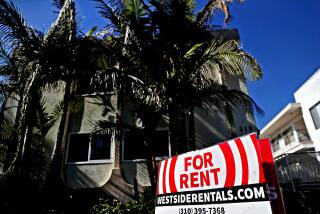Los Angeles County office market flat in first quarter
Cautious growth among white-collar firms kept the Los Angeles County office market flat in the first quarter as average rents and occupancy remained unchanged from a year earlier.
A handful of neighborhoods such as Santa Monica, Pasadena and Glendale are tightening in favor of landlords, but others remain relative bargains for renters.
“Santa Monica is a classic example of where there is a flood of activity by technology-minded companies that have really created an extensive demand, driving down vacancy and driving up rental rates,” said Neal Resnick, managing director of property brokerage Avison Young.
Office vacancy in Santa Monica was 9.6%, down from nearly 12% a year earlier, according to brokerage Cushman & Wakefield. Landlords asked for an average rent of $3.61 a square foot per month, up from $3.49.
That was notably stronger than in the county at large, which held even at 18.8% vacancy and average rents of $2.51 a square foot.
“We are steady as she goes,” said Joe Vargas, area leader at Cushman & Wakefield. “The office market is moving along at the same pace as the economy. It’s coming back, but it’s coming back very slowly.”
The number of leases being signed is rising and tenants are agreeing to longer leases, Vargas said, which is a sign of growing confidence among employers.
Unfortunately for landlords, many businesses are also fitting their individual workers into less space than each had in the past.
“A lot of tenants did more with less,” said John McAniff, managing director of brokerage Jones Lang LaSalle.
In the 1970s, American corporations typically thought they needed 500 to 700 square feet per employee to build an effective office. Today’s average is a little more than 200 square feet per person, and the space allocation could hit a mere 50 square feet by 2015, according to a recent workplace study by Jones Lang LaSalle.
The Westside is the region’s most expensive office market, and as it starts to tighten, landlords in other markets hope to lure tenants fleeing rising rents.
Downtown Los Angeles, which has some of the best upscale office buildings in the West, stands to benefit.
“These are beautiful assets and still a relative bargain compared to other markets,” broker Chris Cooper of Avison Young said. The downtown office market has been soft for decades, though, and vacancy remained mired at nearly 20% in the first quarter.
“Downtown has and will continue to have musical chairs of tenants moving from one high-rise to another,” Cooper said.
Promise for downtown lies in its ongoing growth as a residential neighborhood and destination for dining and entertainment, he said.
It also stands to prosper from the city’s growing public transportation system, including a light rail line to Santa Monica now under construction.
“The next piece of the equation we are all waiting for is a football team and stadium,” Cooper said. “That will create a domino effect” of investments.
Vacancy fell slightly in the Inland Empire and a little more in Orange County, where professional service firms are growing, Vargas said.
More to Read
Inside the business of entertainment
The Wide Shot brings you news, analysis and insights on everything from streaming wars to production — and what it all means for the future.
You may occasionally receive promotional content from the Los Angeles Times.










